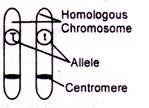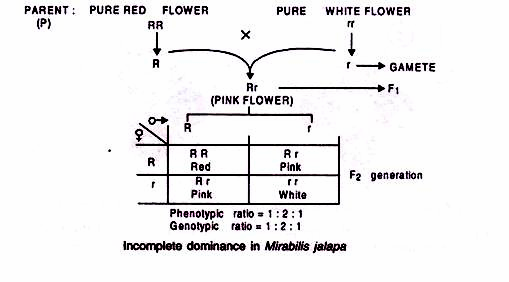ADVERTISEMENTS:
Let us make in-depth study of the pre-Mendelian and post-Mendelian Concepts of Heredity.
Pre-Mendelian Concepts of Heredity:
Various views were prevailing about the process of heredity before the rediscovery of Mendel’s laws of inheritance in 1900.
Some of these concepts are given below:
1. Preformation Theory:
ADVERTISEMENTS:
This theory was proposed by two Dutch biologists, Swammerdam and Bonnet (1720-1793). This theory states that a miniature human, called homunculus, is already present in the egg and sperm which grows into human being after formation of zygote. This theory was soon rejected because this could not be proved scientifically.
2. Theory of Epigenesis:
Proposed by a German biologist Wolff (1738-1794), the theory states that the egg and sperms are undifferentiated cells. The differentiation into various organs/parts takes place only after fertilization in the zygote resulting in the development of adult tissues and organs. This concept is universally accepted.
3. Theory of Acquired Characters:
Proposed by the famous French biologist Lamarck (1744-1829) this theory states that a new character once acquired by an individual shall pass on to its progeny. It means if a man develops a strong muscle by exercise, all his children would have strong muscles. On the other hand, if a person becomes weak all his children would be weak. This concept was totally rejected by Weismann on the basis of experiment on rats performed through 22 generations.
4. Theory of Pengenes:
This theory, proposed by the famous English naturalist Charles Darwin (1809-1882), states that very small, exact but invisible copies of each body organ and component (called gemmules) are transported by the blood stream to the sex organs. These gemmules are assembled in the gametes. After fertilization these gemmules move out to different parts of the body resulting in the development of respective organ. A defective gemmule will lead to the development of defective organ in an individual. This theory too was rejected because it lacked scientific basis.
5. Germplasm Theory:
ADVERTISEMENTS:
This theory, advocated by August Weismann (1889), a German biologist, states that body tissues are of two types, viz., germplasm and somatoplasm. The germplasm refers to the reproductive tissues or cells which produce gametes.
The somatoplasm includes all other body tissues which are not related to sexual reproduction. Thus, transmission of characters from one generation to other takes place only through germplasm. Any change in the germplasm will lead to change in the next generation. This theory is accepted in a broad sense.
Allele or Allelomorph:
A pair of genes controlling the same character and located at the same locus in the homologous chromosomes are known as alleles or allelomorphs.
Ex.
The gene content of the F1 Plant is Tt. These two genes are called alleles because they are located in the same locus of homologous chromosomes. So ‘T’ is allelic to ’t’ or vice versa.
Identical allele in homologous chromosome is homozygous. Ex. TT or tt.
Dissimilar allele in homologous chromosome is heterozygous. Ex. Tt or Rr.
Homozygous always produces one type of garnet but heterozygous products two or more than two types of gamete.
Post-Mendelian Concepts of Heredity:
The basic principles of heredity were initially discovered by Mendel in 1866 and rediscovered by three scientists de Vries, Correns and Tschermak in 1900. Later on these principles were further clarified and confirmed by several workers and some new concepts of heredity were discovered. These new concepts were different from the findings of Mendel. These concepts are often referred to as “Mendelian Deviations” or exceptions or anomalies.
They include:
ADVERTISEMENTS:
1. Incomplete dominance;
2. Co-dominance;
3. Multiple alleles,
ADVERTISEMENTS:
4. Linkage;
5. Lethal genes;
6. Genes interactions;
7. Pleiotropic gene effect;
ADVERTISEMENTS:
8. Polygenes;
9. Environmental effects and
10. Cytoplasmic or material effects.
These are very briefly described below:
1. Incomplete Dominance (Blended Dominance):
Mendel always observed complete dominance of one allele over the other for all the seven characters which he studied in garden pea. Later on, cases of incomplete dominance were sported. For example, in four o’clock plant (Mirabilis jalapa) there are two types of flowers: red and white. A monohybrid cross between red and white flowered plants produced plants with intermediate flower colour also, viz., pink colour in F1, and a modified ratio of 1 red; 2 pink: 1 white was observed in F2 generation.
In a di-hybrid cross showing incomplete dominance both phenotypic and genotypic ratio are identical. However, if out of two pairs of contrasting characters; one pair is completely dominant and other pair is incompletely dominant, then phenotypic ratio = 6: 3: 3: 2: 1: 1; genotypic ratio = 1: 2: 1: 2: 4: 2: 1: 2: 1.
2. Co-dominance:
ADVERTISEMENTS:
In co-dominance both alleles of a gene express their phenotype in heterozygote. Blood group antigens of man present an excellent example of co-dominance. The main difference between co-dominance and incomplete dominance lies in the way in which genes act. In case of co-dominance, both alleles are active, producing functional proteins, while in case of incomplete dominance only one allele (dominant) is active.
One of the most widely known, and the earliest recognized, human blood groups is the ABO blood group. These blood groups arise due to the presence (or absence) of an antigen on the surface of red blood cells; these antigens are produced by the gene i. One dominant allele f this gene, IA, produces antigen A which gives rise to blood group A.
Another dominant allele of the gene i, IB produces antigen B which is responsible for blood group B. In the heterozygote IAIB, both alleles lA and IB produce their respective antigens; as a result, the heterozygotes are classified in the AB blood group.
Marriages between heterozygotes IAIB, having blood group AB, produce three types of progeny. One-fourth of their progeny are homozygous for the allele IA (IAIA) and have A blood group, while another one-fourth have B blood group since they are homozygous for the IB allele (IBIB) . The remaining one-half of the progeny have AB blood group as they are heterozygous (IAIB) and possess both the antigens A and B on the surface of their red blood cells. Thus co-dominance also produces 1:2:1 ratio in F2 (Fig. 5.7).
3. Multiple Alleles:
Mendel always observed two allelic forms of a gene. Now cases are known where a gene has more than two allelic forms, although only two of them can exist in a diploid cell at a time. Existence of more than two alleles for a gene is called multiple alleles. Examples of multiple alleles are ABO blood group alleles in human, coat colour in rabbit and self-incompatibility alleles in tobacco.
4. Linkage:
ADVERTISEMENTS:
Mendel always observed independent assortment of genes, but later on Bateson and Punnett (1906) in sweet pea, Hutchinson in maize and Morgan (1910) in Drosophila observed that genes have tendency to inherit in groups rather than individually. This tendency of two or more genes to remain together in the same chromosome during inheritance is called linkage.
5. Lethal Genes:
A gene that causes death of its carrier when in homozygous condition is known as lethal gene. Mendel’s findings were based on equal survival of all genotypes. In the presence of lethal genes, the normal segregation ratio of 3: 1 is modified into 2: 1 ratio. Lethal genes have been reported both in animals as well as plants.
Coat colour in mice is an important example. Here allele for yellow coat colour is dominant over grey. When a cross is made between yellow and grey, a ratio of 1: 1 for yellow and grey was observed. This indicated that yellow mice is always heterozygous, because yellow homozygotes are never born because of homozygous lethality. Such genes were not observed by Mendel. He always got 3: 1 ratio in F2 for single gene character.
6. Gene Interactions:
When the expression of an allele of one gene pair depends on the presence of a specific allele of another pair, it is known as gene interaction. Mendel observed 9:3:3:1 ratio in F2 from a di-hybrid cross. Later on many deviations of this phenotypic ratio were observed in di-hybrid crosses. The modified ratios included 9: 7; 9: 3: 4; 12: 3: 1; 13: 3: 15: 1 and 9: 6: 1 in different crop plants.
7. Pleiotropic Gene Effects:
Mendel observed that one gene controls the expression of only one character (trait). Later on cases were observed in which one gene was found to control the expression of two or more traits. Example is white eye allele in Drosophila. This allele affects eye colour, shape of spermatheca, fecundity and testicular membrane.
8. Polygenes:
Mendel always observed that each character is controlled by a single gene. Later on Nilsson Ehle observed that some characters are governed by several genes and each of such gene has additive effect in the expression of character. This concept led to the foundation of polygenic inheritance. East (1916) demonstrated that polygenic characters were perfectly in agreement with Mendelian segregation and later on Fisher and Wright provided a mathematical basis for the genetic interpretation of polygenic characters. This too will be discussed in detail later on.
9. Environmental Effects:
Genes can interact not only with genes but also with the environment to produce the phenotype. Thus, phenotype is the result of the interaction between genotype and environment. It leads directly to the concept of penetrance and expressivity. The importance of environment was first realized by Johnnsen. He coined the term genotype and phenotype.
10. Material Effects:
Mendel did not observe any difference between direct and reciprocal crosses. Later investigations revealed the presence of significant difference in the reciprocal crosses, which led to the concept of “cytoplasmic inheritance”.





